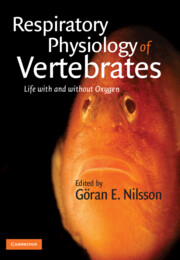Book contents
- Frontmatter
- Contents
- List of contributors
- Preface
- Abbreviations
- Part I General principles
- Part II Special cases
- 5 Adaptations to hypoxia in fishes
- 6 Breathing air in water and in air: the air-breathing fishes
- 7 Air breathers under water: diving mammals and birds
- 8 Vertebrate life at high altitude
- 9 Surviving without any oxygen
- Index
- References
9 - Surviving without any oxygen
Published online by Cambridge University Press: 05 June 2012
- Frontmatter
- Contents
- List of contributors
- Preface
- Abbreviations
- Part I General principles
- Part II Special cases
- 5 Adaptations to hypoxia in fishes
- 6 Breathing air in water and in air: the air-breathing fishes
- 7 Air breathers under water: diving mammals and birds
- 8 Vertebrate life at high altitude
- 9 Surviving without any oxygen
- Index
- References
Summary
Introduction
Most vertebrates cannot survive more than a few minutes without any oxygen. As pointed out in Chapter 1, the high intrinsic rate of oxygen consumption of the brain makes it one of the first organs to fail in anoxia. While medical science struggles to find ways to counteract anoxic tissue damage, unfortunately with quite limited success, evolution has solved this problem a few times, as revealed by the few vertebrates that can survive months without any oxygen. The best-studied examples of such anoxia-tolerant vertebrates are the crucian carp (Carassius carassius) and some North American freshwater turtles in the genera Trachemys and Chrysemys.
It is not a coincidence that these extremely anoxia-tolerant vertebrates are aquatic. The access to oxygen may be temporarily halted in many aquatic habitats, either because water oxygen content becomes severely depleted (see Chapters 1 and 5), or because lung breathers such as turtles lose their access to air for long periods, especially during overwintering. A particularly longlasting and extreme oxygen depletion occurs in many small, ice-covered lakes and ponds in the northern hemisphere. Due to a thick ice cover, which blocks oxygen diffusion as well as light needed for photosynthesis, these waters may become anoxic for several months (Holopainen and Hyvärinen, 1985; Ultsch, 1989). It is under such conditions that crucian carp and turtles have evolved their ability to survive long periods of anoxia.
- Type
- Chapter
- Information
- Respiratory Physiology of VertebratesLife With and Without Oxygen, pp. 300 - 328Publisher: Cambridge University PressPrint publication year: 2010
References
- 5
- Cited by

